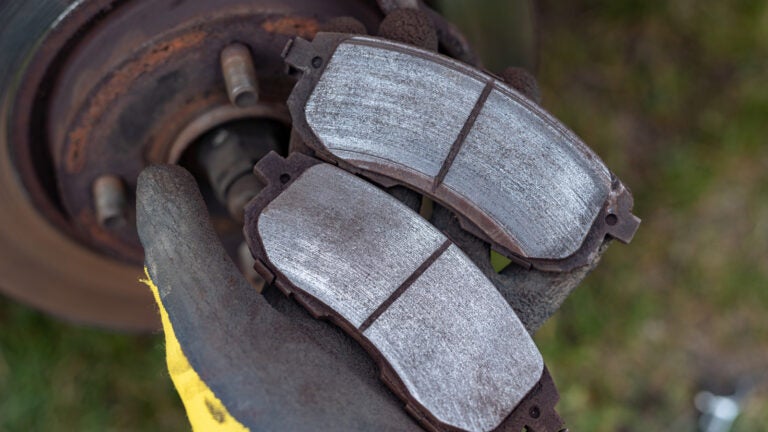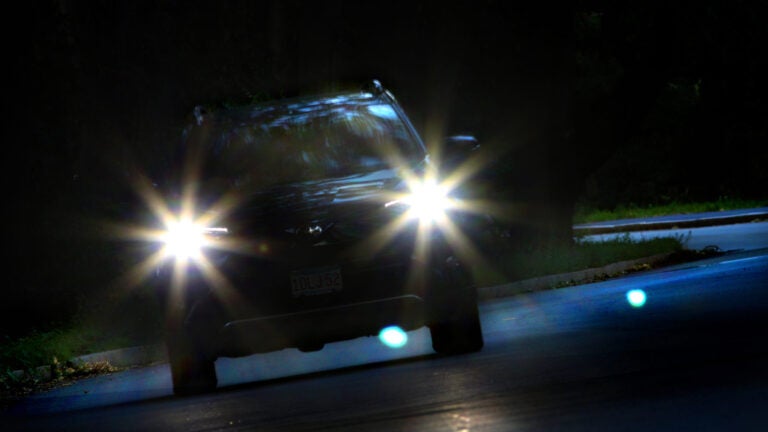Auto Q&A: Monitoring your brake pads
How do you know when it's time for brake work?

Q: My Corolla now has close to 40,000 miles and a friend told me my brakes will be worn out soon, if they are not already. How do I know?— Alison B.A: This may be true, and it’s easy to find out! Brake life is the result of many variables: the type of vehicle, how it’s driven, the specific brake pad composition, environmental conditions, among others.Most brake pads include a wear sensor, a metal tab that begins rubbing on the brake rotor when the pad’s friction material wears thin. It creates a squealing noise that is oddly more apparent at first when the brakes aren’t applied. The noise may quickly alternate or be steady. It will worsen gradually to the point of embarrassment and annoyance. Vehicles not so equipped should have periodic inspections!Checking brake pad thickness, at least a rough estimate, depending on wheel type, may be possible by simply looking through the wheel spokes with an angled inspection mirror. Better is a close look as the tires/wheels are removed for rotation. Color-coded thickness keys are often used to demonstrate remaining pad thickness to the consumer.The friction material on a new brake pad is typically about 8-12 millimeters thick, and those that are ready for replacement are worn down to about 3 mm. It’s important to replace the pads before the friction material wears out completely, as the pad’s steel backing will begin scoring/damaging the brake rotor if contact continues.When brakes are to be serviced, there can be many opinions regarding what should be done. If the brake rotors are in good condition (sufficient thickness, smooth surface finish) and no pulsation has been observed when slowing, a simple pad replacement is usually sufficient. If the rotors are scored or pulsation is evident, they can usually be resurfaced, if remaining rotor thickness is adequate. Many shops simply replace them, as parts prices have become quite reasonable. The downside here is a cheap rotor is nobody’s friend. I’d prefer a slightly imperfect original rotor over an inferior quality replacement. Or insist on a mid grade or better replacement. Same goes for pad quality!Other brake services may be offered/pushed as well, such as caliper replacement, or installing what’s known as a “loaded caliper” which contains new pads. I believe this to be overkill unless the vehicle has many miles or caliper leakage or stickiness has occurred. Flushing/renewing brake fluid is a good idea in any case perhaps each 4-5 years or sooner if specified.Q: My windshield washer stopped working. The wipers are fine, just no spray. How hard would this be to fix?— Gene T.A: This may be pretty simple to fix, depending on your make and model.If both washers stopped at the same time, it’s unlikely the spray nozzles are clogged. And since the wipers work, the fuse should be good.Was any service recently performed under-hood? If so there’s a chance the washer hose somewhere between the pump and nozzles became kinked or disconnected.Can you hear the washer pump run, and/or does a puddle appear on the ground beneath the vehicle? If not the pump is likely faulty. This cylindrical component is usually plugged into the side or bottom of the washer fluid reservoir. Depending on make/model, this could be a $20 part and possibly pretty simple to renew. If it’s a more expensive part or access is poor, testing at the pump for a viable electrical command would be warranted prior to replacement.
Auto Q&A: Green, amber and read taillights: Good idea?
Bob Weber, Chicago TribuneQ: In a recent column, a reader asked about having an amber light showing when the driver had lifted his or her foot from the accelerator. Twenty-five or 30 years ago I saw just such a device while driving into Chicago on the Eisenhower Expressway. The car in front of me had something that looked like a traffic light mounted in the rear window. When the driver was on the gas the green light was on, when he lifted off the accelerator the yellow light was on, when he stepped on the brake the red light was on.I followed him for quite a while and thought this was a pretty clever and useful device. I’ve never seen another one and have no idea whether it is still sold, but it was definitely helpful to me as I followed him on a highway known for situations where traffic speed can change suddenly.— B.J., Mendota, Ill.A: I have been to many automotive parts and accessory expos and have never seen anything like the item you describe. I would not be surprised if some clever reader spots this column and starts making them. But nowadays, it would have to use LEDs for lights, an accelerometer to detect slowing and maybe even Bluetooth for who-knows-why or it may not move off the shelf. Would it be legal? Let’s just say, nobody seems to get a ticket for the obnoxious lights they display.Q: Many cars already have a warning that they are slowing down. Some hybrids and EVs light up the brake lights when you take your foot off the accelerator and engage regenerative braking. My Prius doesn’t, but its regen is relatively mild. Still it’s good enough that brakes are rarely used, and ours lasted over 90K before ever needing any brake work.Several years ago I test drove a BMW I3, and it’s very aggressive regen would turn on the brake lights. It would actually bring the vehicle to a complete stop. Our year-old Tesla 3 is not quite as aggressive as the I3, but still activates the brake lights when you back off the accelerator. The console display shows you the red lights turning on when they are activated. It won’t quite stop the car, but it’s enough braking that you have to be careful on snowy, icy or slick roads. And brakes are expected to last even longer than on the Prius. It’s almost one foot driving.— B.K., ChicagoA: Good point and one that totally slipped my mind. Regenerative braking slows the vehicle much more than traditional coasting as the traction motors morph into generators to recharge the batteries. As such, some carmakers switch on the brake lights to alert following drivers. Although some people believe that regen braking improves fuel economy, it does not. But it does help to keep the propulsion batteries charged.Q: Is the E-85 gas sold in Speedway gas stations safe to use in cars, specifically my 2016 RAV4?— B.O., ChicagoA: When I see that low, low price for fuel, the temptation is to give E85 a try. But unless your vehicle is designed to run on E85 (85 percent alcohol and 15 percent gasoline) don’t do it. Only two 2016 Toyotas were flex fuel compatible, the Tundra pickup and the Sequoia SUV. When in doubt, check your owner’s manual.







